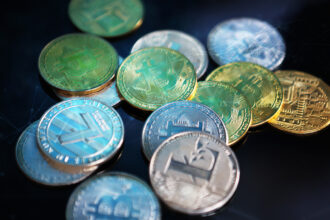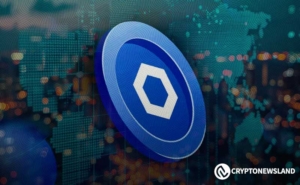XRP and the Future of Decentralized Governance in Global Finance
- XRP's role in cross-border payments highlights decentralized governance's impact on institutional agility and cost efficiency. - Ripple's 2025 SEC settlement and XRP Ledger upgrades (e.g., XLS-30 AMM) accelerated institutional adoption in high-cost corridors. - Banks like SBI and Santander leverage XRP to bypass pre-funding requirements, reducing settlement times from days to seconds. - XRP's $176B valuation reflects structural innovation, though risks include stablecoin competition and regulatory uncert
In the ever-evolving landscape of financial technology, the convergence of decentralized decision-making and blockchain-driven ecosystems is reshaping how value is transferred and governed. At the heart of this transformation lies XRP , Ripple's native token, which has emerged as a critical player in cross-border payments. But XRP's success is not just a story of technological efficiency—it's a reflection of a broader structural shift toward decentralized governance models that empower mid-level managers and institutional actors to act with agility. This alignment between organizational agility and blockchain innovation is redefining the rules of global finance.
Decentralized Governance: From DeFi to Corporate Hierarchies
Decentralized finance (DeFi) protocols have long championed the idea that removing intermediaries can unlock efficiency and transparency. However, the parallels between DeFi's governance models and traditional corporate structures are becoming increasingly apparent. Take the Fidelity® Wise Origin® Bitcoin Fund (FBTC), which employs a multi-layered governance framework that delegates authority to mid-level managers. These individuals are tasked with executing real-time decisions, such as adjusting to regulatory changes or optimizing liquidity, without waiting for top-down approval. This model mirrors how DeFi protocols operate, where smart contracts automate governance and reduce reliance on centralized authorities.
The key takeaway is that decentralized governance—whether in a blockchain network or a corporate hierarchy—prioritizes speed, adaptability, and trust. Mid-level managers, much like validators or liquidity providers in DeFi, become the linchpins of operational efficiency. For example, Fidelity's mid-level teams leveraged predictive analytics to reduce machine downtime at Acme Industries and Spotify's Agile Squad Model to innovate products like “Discover Weekly.” These examples underscore how decentralized decision-making fosters innovation and responsiveness, traits that are now critical in a world where financial systems must adapt to volatile markets and regulatory shifts.
XRP's Strategic Position in Cross-Border Payments
XRP's role in cross-border payments is a case study in how decentralized governance can optimize traditional financial infrastructure. Ripple's XRP Ledger (XRPL) has evolved into a high-performance blockchain that enables near-instant transactions at a fraction of the cost of SWIFT or other legacy systems. The August 2025 resolution of the Ripple-SEC dispute—a landmark ruling that clarified XRP's status as a non-security—has further accelerated institutional adoption.
Banks like SBI Holdings, Standard Chartered, and Santander are now leveraging XRP to streamline international remittances, particularly in high-cost corridors such as Asia-Pacific and Latin America. The token's utility as a “bridge asset” allows institutions to bypass pre-funding requirements and settle transactions in real time. For instance, SBI's XRP-based remittance network has reduced settlement times from days to seconds in corridors like Japan to the Philippines, where remittance fees traditionally eat up 6% of transaction value.
Technological upgrades to the XRP Ledger, such as the XLS-30 amendment introducing a native Automated Market Maker (AMM), have also enhanced liquidity and trading efficiency. This innovation is critical for cross-border use cases, where low slippage and high throughput are non-negotiable. Meanwhile, Ripple's RLUSD stablecoin—backed by BNY Mellon—provides a regulated on-ramp for institutions, further cementing XRP's role in a hybrid financial ecosystem.
The Synergy Between Governance and Infrastructure
The structural shift toward decentralized governance is not just theoretical—it's a practical enabler for XRP's adoption. Just as mid-level managers in corporate hierarchies are empowered to act autonomously, XRP's design allows financial institutions to bypass bureaucratic bottlenecks in cross-border payments. This synergy is evident in how Ripple's partners have integrated XRP into their workflows:
- Regulatory Agility: The SEC's 2025 ruling removed a major hurdle, allowing banks to adopt XRP without fear of securities law violations. This mirrors how decentralized governance models in DeFi preemptively address regulatory risks through modular compliance frameworks.
- Operational Efficiency: By decentralizing decision-making, institutions can route transactions through XRP when it offers cost or liquidity advantages, much like how DeFi protocols automate asset allocation.
- Scalability: The XRP Ledger's throughput (1,500 transactions per second) and low energy consumption make it a scalable solution for high-volume corridors, a trait that aligns with the scalability challenges faced by DAOs and other DeFi protocols.
Investment Implications and Risks
For investors, XRP's positioning in cross-border payments is a compelling case of structural innovation. The token's market capitalization of $176 billion in 2025 reflects growing institutional confidence, while its role in reducing pre-funding costs and enhancing liquidity makes it a strategic asset for banks. However, the path forward is not without risks:
- Competition from Stablecoins and CBDCs: While XRP offers speed and efficiency, stablecoins like USDC and central bank digital currencies (CBDCs) may capture market share in corridors where volatility is a concern.
- Regulatory Uncertainty: Although the SEC's 2025 ruling was a win, ongoing scrutiny of DeFi protocols and cross-border transactions could introduce new compliance hurdles.
- Adoption Rates in Emerging Markets: XRP's success hinges on its ability to penetrate high-cost corridors, which requires continued partnerships and infrastructure investment.
Despite these challenges, the structural shift toward decentralized governance—both in corporate hierarchies and blockchain ecosystems—creates a tailwind for XRP. The token's alignment with institutional needs, regulatory clarity, and technological upgrades positions it as a key player in the next phase of global finance.
Conclusion: A New Paradigm for Value Transfer
The rise of XRP in cross-border payments is not an isolated trend—it's a symptom of a larger shift toward decentralized governance models that prioritize agility and efficiency. Just as mid-level managers are becoming the engines of innovation in traditional corporations, XRP is enabling financial institutions to act with unprecedented speed and autonomy. For investors, this represents a unique opportunity to bet on a structural transformation rather than a fleeting market cycle.
As the financial world grapples with the complexities of global remittances, regulatory compliance, and technological disruption, XRP's role as a bridge between decentralized governance and institutional infrastructure will only grow. The question is not whether XRP will succeed—it's how quickly the rest of the financial system will catch up.
Disclaimer: The content of this article solely reflects the author's opinion and does not represent the platform in any capacity. This article is not intended to serve as a reference for making investment decisions.
You may also like
Altcoins Surge as Market Trends Point to Growth
In Brief Market trends show potential for altcoin growth within a mini-uptrend. Macroeconomic factors and geopolitical events add to market uncertainty. Investors should stay informed through news updates for strategic decisions.

Bitcoin News Today: Bitcoin's Bleeding Metric: A Market in the Crosshairs of Correction
- Bitcoin's MVRV ratio fell below its 365-day SMA, signaling potential extended market corrections as significant portions of the network enter negative value territory. - Bearish on-chain metrics like negative Spot Taker CVD and funding rates reinforce selling pressure, with altcoins like TRX showing similar downward momentum. - Key support levels at $108,800-$110,000 are critical; failure to hold could trigger further price declines and retesting of the 50-day EMA. - Market participants monitor technical

Ethereum News Today: Investor Frenzy Redirects Capital to High-Upside Altcoins Like MAGACOIN FINANCE
- MAGACOIN FINANCE's presale nears completion, drawing comparisons to Ethereum and Cardano due to rapid investor demand and Ethereum-based infrastructure. - Ethereum's impending $2B staking unlock creates liquidity shifts, redirecting capital toward high-upside altcoins like MAGACOIN FINANCE amid market volatility. - Cardano shows stagnation while meme-DeFi hybrids like Moonshot MAGAX (projected 1,000x ROI) attract attention with asymmetric returns in a maturing crypto market. - Bitcoin's 12% correction co

Chainlink Price Pulls Back as $23 Support Holds but Downside Risks Persist
